We got robbed 30 seconds after we left the airport. By the police. In broad daylight.
On Mount Ajusco, Mexico City, looking towards Iztaccíhuatl and Popocatépetl
Our time in New York was coming to an end. We wanted to take advantage of staying in the Western-Northern hemisphere to climb to the top of Mexico, in 2007.
Leaving the gates of the Mexico City airport in our rented small Volkswagen, we stopped at the first major busy intersection. As the traffic lights switched to green, a policeman jumped into the middle of the square, waving towards us to stop and talking rapidly in Spanish, somehow insinuating that we run a red light. He handed my driver license to a companion, who added it to a stack of other licenses and proceeded to menacingly shuffle them like playing cards. We figured that they were demanding 1000 American Dollar, a suggestion we shrugged off. “How much do you have?” His English was perfect. Foolishly, I took a bundle of notes from my pocket, intending to give him 20 Dollar in exchange for my license. All in a split second, he reached through the car window, grabbed the entire bundle, threw my license back into the car and blew his whistle, stopping the entire traffic for us to weave back into the busy lane. No time for arguments.
The loss of money was eclipsed by the humiliation of having fallen prey to this scam, in spite of our abundant travel experiences from around the globe. We got over it very quickly. It was to remain the only adverse incident during what would be an exciting and thoroughly enjoyable three-week long journey in a wonderful country.
***
When you want to climb to high up the top, you need to acclimatize by progressively gaining heights over a period of time, just like in UNICEF. Climb too fast too high, and you are liable to being out of breath, suffering from hallucinations and taking idiotic decisions.
So we climbed some smaller mountains first. Ajusco is the highest point of Mexico City and a mountain in itself, at close to 4000 meter. The panorama over the biggest city in North America is spectacular, unless air pollution obstructs any views. Mexico City belonged to the most polluted cities in the world, but has cleaned up in the past 10 to 20 years. Our visit happened in 2007, and the smog was quite heavy. (Click on any image to enlarge)
***
Sun and Moon
Just outside greater Mexico City, the ruins of
Teotihuacan are a place of massive pyramids and profound mystery. The ancient
City of the Gods was settled as early as 400 B.C. and became the most powerful and influential city in the region by 400 A.D. By the time the Aztecs found the city in the 1400s and named it Teotihuacan, it had been abandoned for centuries. Archaeological research is still discovering new tunnels and chambers. It was designated a UNESCO World Heritage Site in 1987.
The tallest of all the pyramids is believed to be the site of many magical ceremonies. It is referred to as the Pyramid of the Sun. It predates all of the Mayan structures by several centuries.
The Pyramid of the Moon is the second largest pyramid in this city, and was dedicated to the Great Goddess. It mimics the contours of Cerro Gordo. Compare the contours on the left side of the pyramid with the contours of the mountain in the center background.
The area of Teotihuacan contains around 2,000 single-story apartment compounds, as well as various plazas, temples and palaces of nobles and priests.
Teotihuacan also has a nice restaurant with the colourful decorations typical for Mexico.
****
Our next destination also had to do with sun and moon. To continue our acclimatization, we climbed Nevado de Toluca, an extinct volcano near the city of Toluca.
With an elevation of 4680 meter, Nevado de Toluca is higher than any mountain of the contiguous USA. A climb to the top is not a trivial undertaking.
The crater of Nevado the Toluca, seen from the summit. The caldera has two lakes, the Lago del Sol (Sun Lake) and the smaller, but deeper, Lago de la Luna (Moon Lake).
*****
Cholula
The city of Cholula has given its name to a well known hot sauce. It is also one of the oldest cities on the continent. The Great Pyramid of Cholula, also known as Tlachihualtepetl (Nahuatl for "made-by-hand mountain"), is the largest pyramid by volume known to exist in the world today. The Great Pyramid of Giza is considerably higher, but not as voluminous.
Cholula has 38 churches, and the Iglesia de Nuestra Señora de los Remedios sits on top of the pyramid.
The Iglesia de Nuestra Señora de los Remedios has a phenomenal interior.
Some cultural festivities were going on, with a lot of music and parades. Looking at the photos today, I cannot but wonder whether a visit to Mexico could be arranged as a shock-therapy for the Taliban.
*****
The Sleeping Beauty
Mexico has many beauties, and one is sleeping.
Iztaccíhuatl is the "white woman" in Nahuatl. It is sometimes called the Mujer Dormida ("sleeping woman") in Spanish. You may, in the picture above, make out (from left to right) the head, the chest, the belly, the knees and the feet. The chest is the highest point, and we were going to climb it. Also, take note of the smog in front of the mountain. (Click on any image to enlarge).
We had joined a guided tour for this and the next mountain, mainly to overcome the logistic challenges associated with the approach.
Just like in UNICEF, our local guides compensated the lack of planning with good negotiation skills. They had forgotten to book suitable accomodation in one of the mountain cabins, but managed to secure a place on the floor of the museum at the Paso de Cortes, where we spent the first night on the mountain. It is something very satisfying to watch the sunrise high on a mountain. On summit day, we had left our camp in the middle of the night. At the crack of dawn, we are preparing for a more difficult stretch.
Making our way to the summit of Izta. In the background the famous El Popo (short for Popocatépetl), a still active volcano, which is off limits to climbers.
The historical and cultural value of Puebla's architecture is a major reason the city was chosen as a UNESCO World Heritage Site. It is the fourth largest city of Mexico, with more than 3 million people. Architectural styles range from Renaissance to Mexican Baroque. The city is also famous for its cuisine (mole poblano, chiles en nogada) and pottery. However, most of its economy is based on industry.
It is well worth exploring the center of the city.
Puebla has many museums and art galleries. This gallery had a special appeal.
The Puebla Cathedral took 300 years to complete.
*****
Pico de Orizaba
Pico de Orizaba, also known as Citlaltépetl is the highest peak in Mexico. It rises 5,636 metres (18,491 ft) above sea level. Pico de Orizaba is also the third highest peak in North America. It is the second most prominent volcanic peak in the world after Mount Kilimanjaro.
High camp on Pico de Orizaba, where we spent the night. The rest of the world disappears below the clouds.
On summit day, we still had to climb another 1400 meter, in very thin air.
View from the summit into the crater of the volcano, and onto Mexico.
*****
Oaxaca
Having done with the climbing, we again rented a car for more leisurely exploits. The city of Oaxaca de Juárez is worth visiting, on account of its architectural and cultural charms. In recognition of its treasure of historic buildings and monuments, the city centre was also designated a UNESCO World Heritage Site.
Our little hotel
We were in Mexico in the middle of November, and artefacts remaining from the celebrations of the
Day of the Dead were in attendance everywhere. The celebration is not solely focused on the dead. It is also common to give gifts to friends such as candy sugar skulls, to share traditional
pan de muerto with family and friends, and to write light-hearted and often irreverent verses in the form of mock epitaphs dedicated to living friends and acquaintances, a literary form known as
calaveras literarias.
Here, Gabi is trying to engage in a conversation. The image triggered recollections of many attempts to convince UNICEF senior management of the need for substantive UNICEF reforms.
The cathedral in the Zocola (central plaza) in Oaxaca
Street art and museums are in good supply
A walk along the
Macedonio Alcalà is an experience any time of the day. The iconic street is lined with endless shops, restaurants, and cafes. It is also home to some of the best street food in Oaxaca, including
chicatanas (fried ants).
*****
The Pacific
We made our way to Puerto Escondido, on the west coast of Mexico. Perhaps not as developed as Mexico's top beach vacation destinations, Escondido was blissfully free of any crowds.
Surfers happily mingle with retirees, for a thoroughly relaxing atmosphere. But we didn't stay long.
In the 1950s and ’60s, the international jet set, Hollywood stars and millionaires used to socialize in Acapulco. As a young boy in Germany, even I had heard about the lure of Acapulco. Forty years later, we decided to visit.
We managed to stay in the Los Flamingos Hotel. It has a fantastic setting, as it is situated atop a tall, scrub-covered cliff and has an amazing view of Pacific Ocean sunsets.
During Hollywood’s Golden Age, macho-celebrities like
John Wayne,
Cary Grant, Errol Flynn, and
Johnny Weissmuller (of Tarzan fame), were regulars at Los Flamingos. However, by 2007 the place looked far more tired, which is a blessing as it has become quite affordable, if not cheap.
Here is a list of drinks that were invented at the Hotel Los Flamingos, some of which we tried and enjoyed.
Unfortunately, due to an upsurge in gang violence and homicide numbers since 2014, Acapulco has become one of the most deadly cities in the world.
*****
One more adventure was lying ahead, near the city of Uruapan.
In Uruapan. The photograph reminds me, that the first
Mexico Beetle was built in 1954; the last of more than 21 million
Beetles was assembled in Mexico almost 50 years later, in 2003. The Mexico Käfer was sold also in Europe but remained popular in Mexico.
*****
Paricutin
There are seven natural (not manmade) wonders, which include the the Grand Canyon, Mount Everest, the Northern Lights, Victoria Falls, the Harbor of Rio de Janeiro, the Great Barrier Reef and Paricutin Volcano. The list varies by source, but this list has been published by the CNN.
Paricutin is a cinder cone volcano that stands about 425 Meter above its surroundings. From the nearest town it is best to take a horse to the base of the volcano. Paricutin is in the center of the photograph.
We left the horses at the foot of Paricutin, and climbed to the top for a view into the crater, which is still emitting fumes.
The cone has only existed since 1943. One day in February, the farmer Dionisio Pulido had been working his land. Suddenly the ground nearby swelled upward. Pulido heard hissing sounds and smoke, which smelled like rotten eggs. Within hours, a small crater appeared. A friend later reported that: "when night began to fall, we heard noises like the surge of the sea, and red flames of fire rose into the darkened sky, some rising 800 meters or more into the air, that burst like golden marigolds, and a rain like fireworks fell to the ground".
Gabi on her way down through the soft, black ashes of Paricutin, back to our horses.
From that day in 1942, Paricutin continued to erupt for another 9 years, growing to its present height. The eruption significantly damaged an area of more than 233 square kilometers. Two towns were completely evacuated and buried by lava. Hundreds of people had to permanently relocate. Now, the volcano is considered to be dormant.
The ruins of San Juan Parangaricutiro Church, surrounded by the hardened lava of the volcano.
The church has become a pilgrimage site. The old altar, which was spared by the burning lava, is regularly adorned with fresh candles and flowers.
Paricutin (the cone towards the left side of the image) at sunset.
*****
Other photo-stories by Detlef:











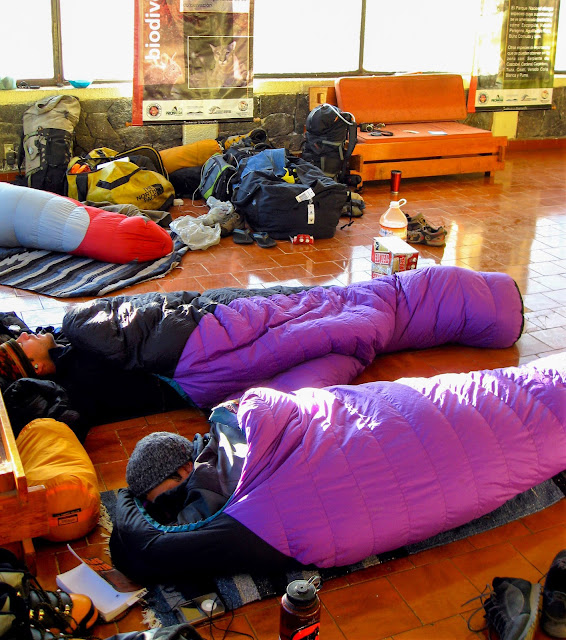




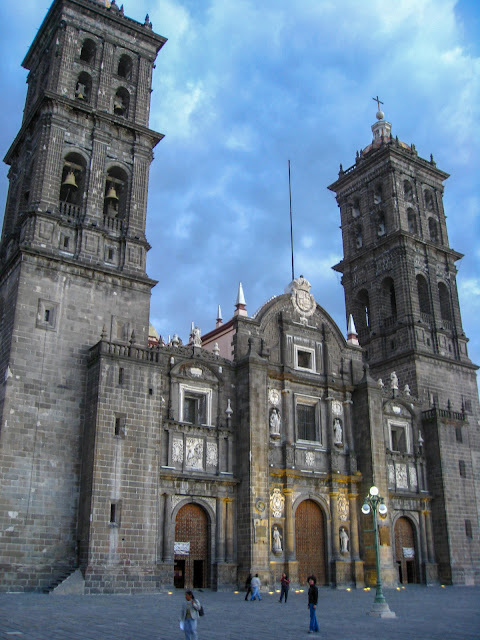



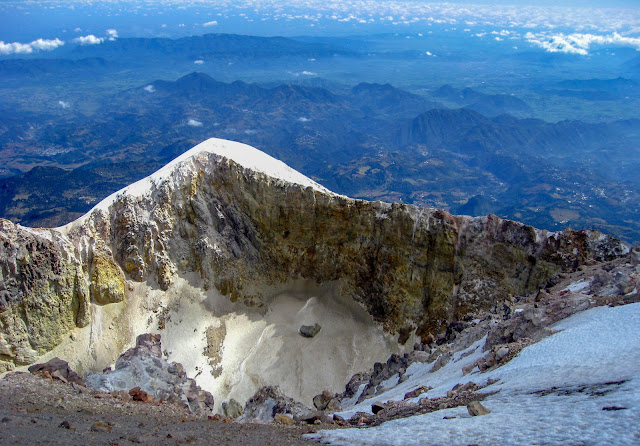








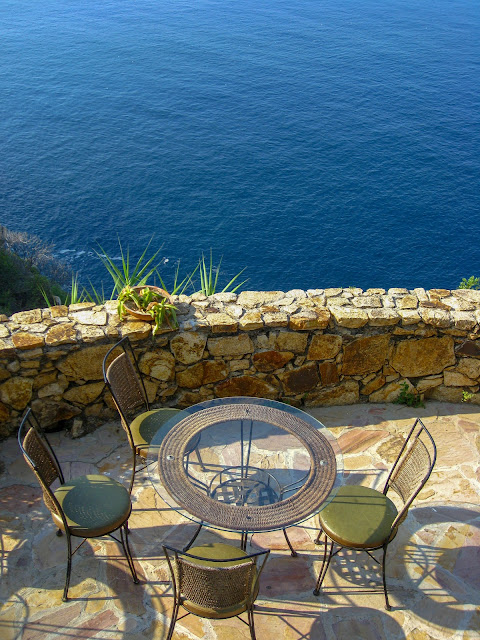

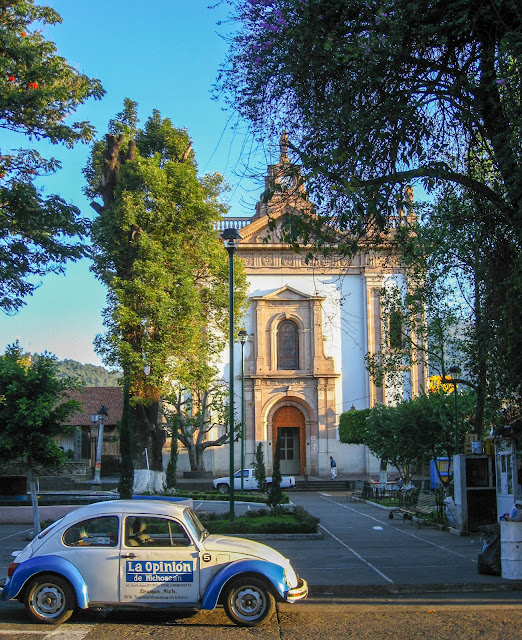


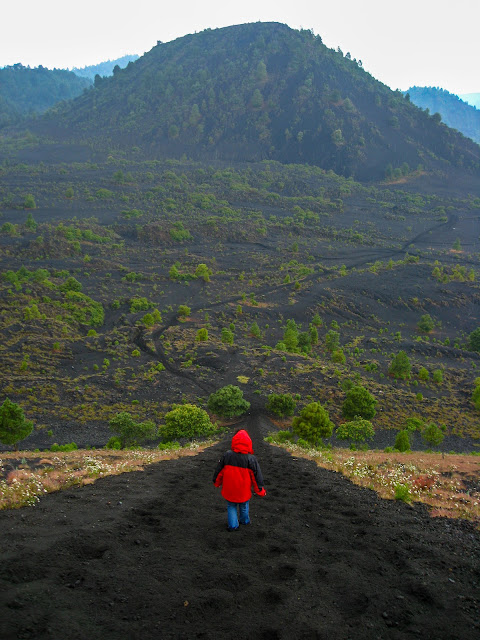
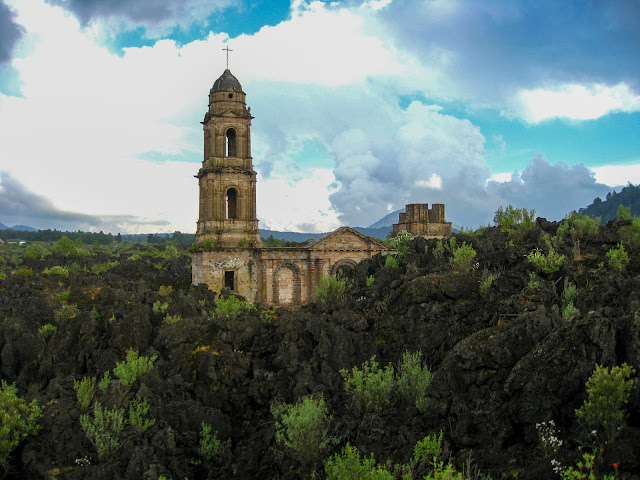


Fantastic travel report and very beautiful photos. It showed many areas in Mexico I missed. (By the way, we also got robbed by a traffic policeman during the World Cup 1986...)
ReplyDeleteThank you Detlef for sharing this terrific report on your trip to Mexico, so full of variety, challenge and charm. Just last month I visited Oaxaca for the first time and it remains exactly as you described. Hope you are happy healthy and thriving. Cheers from Boston. Liz
ReplyDeleteJuan Aguilar wrote:
ReplyDeleteThank you Deflet for your wonderful narrative of Mexico which brought back memories of the memorable XUNICEF Reunion in 2017. Warmest regards from Guatemala. Juan Aguilar
Deflect thousands thanks for this colorful and vivid travel account. It brought memories for my post graduate studies in Mexico in the early 80’ .
ReplyDeleteGoing back is in my retiree bucket list.
Michel Saint-Lot